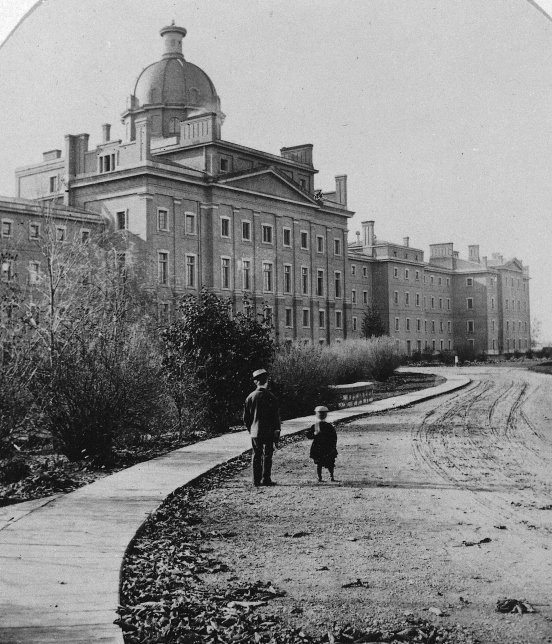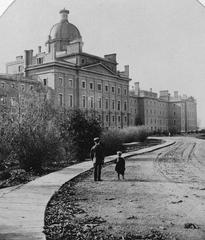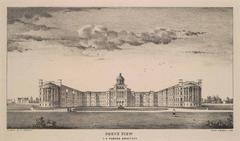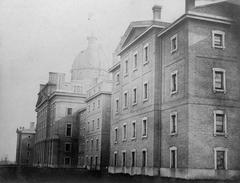
Visiting the Centre for Addiction and Mental Health (CAMH) Toronto: A Detailed Guide to History, Visitor Information, and Responsible Tourism
Date: 14/06/2025
Introduction
The Centre for Addiction and Mental Health (CAMH) stands at the forefront of mental health and addiction care in Canada. As the country’s largest mental health teaching hospital and research centre, CAMH is renowned for its innovative treatment, advocacy, and educational initiatives. Located in Toronto’s Queen Street West neighborhood, CAMH’s campus has evolved from its origins as the Provincial Lunatic Asylum in 1850 to a symbol of compassionate, evidence-based care and inclusive community engagement. This guide offers a comprehensive overview of CAMH’s history, facilities, visitor information, and practical tips to ensure a respectful and meaningful experience.
For the latest updates on visitor hours, events, and policies, always refer to the official CAMH website. For additional historical context, see Wikipedia and local perspectives on BlogTO.
Table of Contents
- Introduction
- Historical Evolution of CAMH
- Modern Campus and Main Facilities
- Visiting Information: Hours, Tours, Fees
- Accessibility and Getting There
- Responsible Tourism: Guidelines and Etiquette
- CAMH’s Role in Cultural Heritage and Community
- Events, Programs, and Educational Resources
- Frequently Asked Questions (FAQ)
- Summary and Final Tips
- References
Historical Evolution of CAMH
From Asylum to Urban Village
CAMH’s Queen Street West campus traces its roots back to the founding of the Provincial Lunatic Asylum in 1850, the first purpose-built psychiatric hospital in what was then Upper Canada (Wikipedia). The original design reflected 19th-century approaches, focused on order and separation, which over time contributed to the stigma surrounding mental health institutions.
In the 20th century, several institutions—including the Donwood Institute (pioneers in addiction care), the Clarke Institute of Psychiatry (a leader in forensic psychology and research), and the Addiction Research Foundation—merged to form CAMH in 1998. This amalgamation established a holistic approach to mental health, spanning clinical services, research, and community programs.
Preserved Heritage
The campus retains significant historical features, most notably the original asylum wall, now maintained by the Psychiatric Survivor Archives of Toronto (BlogTO). This wall serves as a powerful symbol of both the challenges and progress in mental health care.
Modern Campus and Main Facilities
Today, the Queen Street West site has been redeveloped into an accessible “urban village” that integrates green spaces, public art, research centres, and inclusive care facilities. Notable buildings include the McCain Complex Care & Recovery Building and Ontario’s only standalone psychiatric emergency department.
CAMH is recognized for its commitment to equity, inclusion, and Indigenous health. In 2016, a sweat lodge was constructed to support Indigenous patients, reflecting CAMH’s efforts to honor diverse communities.
Visiting Information: Hours, Tours, Fees
General Visiting
- Campus Access: The outdoor spaces and certain educational areas are open to the public. CAMH is a working hospital; access to clinical or patient areas is restricted.
- Patient Visitation: Visits to patients are by arrangement and subject to unit-specific policies. Always check with clinical staff before visiting.
- Guided Tours: CAMH occasionally offers guided tours and educational sessions during special events. Check the CAMH website or contact the Public Affairs Office for information on upcoming opportunities.
- Admission Fees: There are no general admission fees. Some special programs or events may require advance registration.
On-Site Resources
- CAMH Library: Open to the public for research and learning (CAMH Library).
- Patient and Family Learning Space: Provides information on programs and community services.
- CAMH Store: Offers books and materials supporting mental health education (CAMH Store).
Accessibility and Getting There
- Location: 1001 Queen Street West, Toronto, ON, M6J 1H4. The campus is close to downtown and attractions like Trinity Bellwoods Park.
- Public Transit: The 501 Queen streetcar stops at the main entrance; multiple TTC routes serve the area.
- Parking and Bicycles: Limited paid parking on-site and in nearby lots. Bike racks are available.
- Accessibility: The campus is barrier-free, with accessible entrances, elevators, and restrooms. Service animals are welcome (Destination Toronto).
Responsible Tourism: Guidelines and Etiquette
- Respect Privacy: As an active hospital, respect the privacy and dignity of patients, families, and staff. Clinical areas are off-limits to the general public.
- Photography: Prohibited inside clinical spaces; permitted outdoors in public areas such as the asylum wall, with respectful conduct.
- Behavior: Quiet, considerate behavior is expected throughout the campus.
- Stigma Reduction: Engage thoughtfully, use person-first language, and participate in public events to support mental health advocacy.
CAMH’s Role in Cultural Heritage and Community
CAMH is more than a healthcare institution; it is a steward of mental health history and a leader in reducing stigma. The preserved asylum wall and public art installations offer tangible links to the past. The institution’s ongoing redevelopment projects symbolize progress toward recovery and community integration.
CAMH also acknowledges its presence on Indigenous land and continues to foster cultural safety and inclusivity through dedicated programs and spaces.
Events, Programs, and Educational Resources
- Events Calendar: CAMH hosts seminars, workshops, and public events throughout the year (Events Calendar).
- Toronto Flower Market: Held monthly (May–October) on campus grounds.
- Educational Programs: Group visits and presentations can be arranged for students, professionals, and the community.
Virtual tours, interactive learning sessions, and public art displays are available to enhance the visitor experience.
Frequently Asked Questions (FAQ)
Q: What are CAMH’s public visiting hours?
A: The outdoor grounds are accessible during daylight hours. Patient visitation requires prior arrangement; check with the relevant unit for details.
Q: Is there an admission fee or ticket required?
A: No, CAMH does not charge admission fees. Some events may require registration.
Q: Are guided tours offered?
A: Occasionally, during public events or by arrangement. Monitor the CAMH website for updates.
Q: Is the campus wheelchair accessible?
A: Yes, with barrier-free entrances, elevators, and accessible washrooms.
Q: Can I take photographs?
A: Outdoor photography is generally allowed; photography in clinical areas is strictly prohibited.
Q: Are pets allowed?
A: Only service animals are permitted.
Q: Is the original asylum wall accessible to visitors?
A: Yes, the wall is preserved on-site and accessible outdoors.
Summary and Final Tips
A visit to CAMH offers an opportunity to engage with Toronto’s rich mental health history and evolving care landscape. Highlights include the preserved asylum wall, public art, and educational programming. CAMH’s commitment to equity and inclusion, along with its modern facilities, make it a welcoming space for all visitors.
- Always respect privacy and confidentiality.
- Check the CAMH website for the latest visitor information.
- Consider attending public events or exploring educational resources to deepen your understanding of mental health care.
By visiting CAMH, you not only explore a landmark in Toronto’s history but also contribute to the ongoing conversation around mental health and addiction care in Canada (Wikipedia, BlogTO, CAMH).
References and Further Reading
- Centre for Addiction and Mental Health (CAMH): History, Tours, and Visitor Information
- Visiting CAMH: Cultural History, Visitor Information, and Responsible Tourism Tips in Toronto
- Centre for Addiction and Mental Health Wikipedia Page
For maps, images, and accessibility guides, refer to the CAMH website. Descriptive alt-text is recommended for all visual materials to ensure accessibility.






























































































































































































